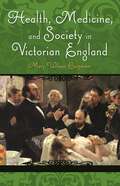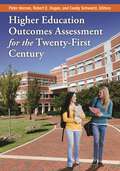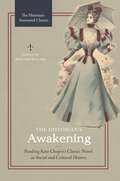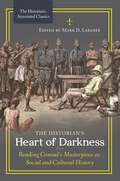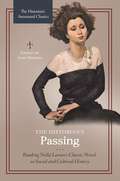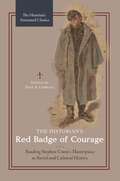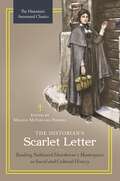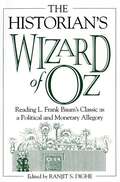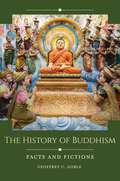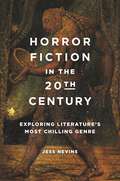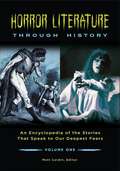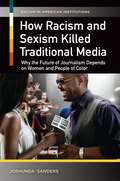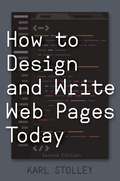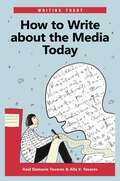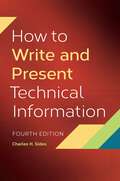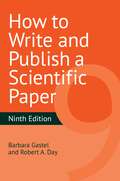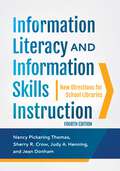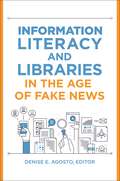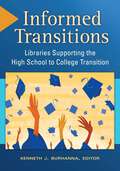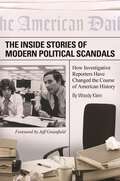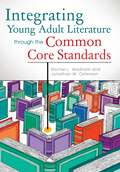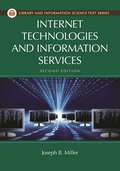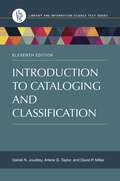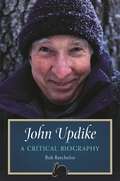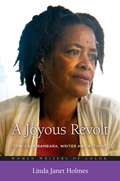- Table View
- List View
Health, Medicine, and Society in Victorian England (Victorian Life and Times)
by Mary Wilson CarpenterThis work offers a social and cultural history of Victorian medicine "from below," as experienced by ordinary practitioners and patients, often described in their own words.Health, Medicine, and Society in Victorian England is a human story of medicine in 19th-century England. It's a story of how a diverse and competitive assortment of apothecary apprentices, surgeons who learned their trade by doing, and physicians schooled in ancient Greek medicine but lacking in any actual experience with patients, was gradually formed into a medical profession with uniform standards of education and qualification. It's a story of how medical men struggled with "new" diseases such as cholera and "old" ones known for centuries, such as tuberculosis, syphilis, and smallpox, largely in the absence of effective drugs or treatments, and so were often reduced to standing helplessly by as their patients died. It's a story of how surgeons, empowered first by anesthesia and later by antiseptic technique, vastly expanded the field of surgery—sometimes with major benefits for patients, but sometimes with disastrous results. Above all, it's a story of how gender and class ideology dominated both practitioners and patients. Women were stridently excluded from medical education and practice of any kind until the end of the century, but were hailed into the new field of nursing, which was felt to be "natural" to the gentler sex. Only the poor were admitted to hospitals until the last decades of the century, and while they often received compassionate care, they were also treated as "cases" of disease and experimented upon with freedom. Yet because medical knowledge was growing by leaps and bounds, Victorians were fascinated with this new field and wrote novels, poetry, essays, letters, and diaries, which illuminate their experience of health and disease for us. Newly developed techniques of photography, as well as improved print illustrations, help us to picture this fascinating world. This vivid history of Victorian medicine is enriched with many literary examples and visual images drawn from the period.
Higher Education Outcomes Assessment for the Twenty-First Century
by Peter Hernon, Robert E. Dugan, and Candy SchwartzThis book discusses recent trends in outcomes assessment, examines how state governments are reshaping the national discussion with higher education, and explains how libraries must respond to these changes.Higher Education Outcomes Assessment for the Twenty-first Century focuses on recent developments in outcomes assessment, especially from the perspectives of the federal government and state governments, as well as foundations concerned about the state of higher education. The authors identify the significant changes that these stakeholders call for—information that academic librarians and anyone following outcomes assessment need to be aware of—and interpret the discussions to identify implications for libraries.Building upon the foundation of knowledge presented in the previous two Libraries Unlimited Outcomes Assessment in Higher Education titles, this book provides readers with up-to-date coverage of topics such as the emerging metrics used to define student and institutional success; the increased importance of accountability and the need to compare and assess the performance of programs and institutions rather than individual courses; and the shift in prioritizing student outcomes over student learning outcomes. The authors also spotlight the critical need for libraries to fit their role within the national discussion and suggest ways in which library managers and directors can play a role in redirecting the discussion to their benefit.
The Historian's Awakening: Reading Kate Chopin's Classic Novel as Social and Cultural History (The Historian's Annotated Classics)
by Bernard KoloskiThe Historian's Awakening is a full commentary on the text (included) that provides social and cultural history context, discussions of the author and her times as well as valuable insight into historical forces that shaped people's lives.Kate Chopin's classic novel about a modern woman who desires to break free from tradition endures, in part, due to its critical and thought-provoking themes about society. While many editions of Kate Chopin's classic novel are in print, only The Historian's Awakening deals exclusively with the 19th-century social and cultural environment from which the novel emerged. In The Awakening, Kate Chopin portrays a modern woman who seeks autonomy, subjected to intense social and cultural conventions that first draw her out of her lifelong solitude but ultimately leave her feeling even more alone. This newly annotated edition focuses on how 19th-century ideas about class, gender, ethnicity, and modernity affect a courageous woman's life. Challenging prevailing scholarship by situating the novel within a rich historical context, it examines the social and cultural realities of the 1890s and explains how, in the novel, these forces combine with an emerging modernity to liberate and unsettle its female protagonist.
The Historian's Heart of Darkness: Reading Conrad's Masterpiece as Social and Cultural History (The Historian's Annotated Classics)
by Mark D. LarabeeFiction has power to portray historical truth. This book presents Joseph Conrad's Heart of Darkness to students and general readers as an insightful guide to the history of Europe and Africa in the late nineteenth and early twentieth centuries.The phrase "heart of darkness" has become a term commonly used to conjure an ominous sense of hidden or deeply rooted evil. How did these words become so evocative? The answer lies in the richness and acute insight of Heart of Darkness, Joseph Conrad's story based on his 1890 journey on the Congo River. Conrad's novella illustrates many crucial themes of European and world history through the last two centuries: civilization; exploration; colonialism and imperialism; race and conflict based on race; trade and globalization; commercial exploitation; and the impact of changing technology, especially for communication and transport. Heart of Darkness deserves to be studied today for its value as social and cultural history. In this edition, Conrad's story is shown to reveal important truths not only about Europe and Africa a century ago, but also about the historical forces that shape the world we live in now.Featuring the texts of both Heart of Darkness and Conrad's autobiographical Congo Diary along with more than 200 annotations, this book enables readers to appreciate the connections between Conrad's writing and its historical context. Introductory essays explain how Conrad was uniquely positioned to chronicle history, provide critical background information on how Europeans partitioned Africa and created the Congo Free State, and describe how the ivory and rubber trades brutalized the natives. Readers will learn how Conrad contributed to European awareness of the atrocities committed and understand how the story's literary qualities form an essential part of its historical meaning. The numerous illustrations and maps depicting the historical Congo Free State provide a visual element to the story of Heart of Darkness—a fictionalized tale that can be interpreted as history and that can help us interpret today's postcolonial, globalized world.
The Historian's Passing: Reading Nella Larsen's Classic Novel as Social and Cultural History (The Historian's Annotated Classics)
by Lynn DominaThis meticulously annotated edition of Nella Larsen's novel Passing contextualizes the novel's many historical and cultural references and introduces readers to a central theme: crossing the color line in the hopes of living a more privileged life.Nella Larsen's Passing is widely regarded as a classic novel of African American literature—a groundbreaking work in which the author keenly depicted an under-acknowledged element of early 20th-century American life: crossing the "color line" in the hopes of living a more privileged life. Now, readers can appreciate the full text of Larsen's masterpiece, accompanied throughout by invaluable annotations that transform this classic into a fascinating historical documentation of American life and society during the Harlem Renaissance. This meticulously annotated edition draws on the wealth of race scholarship that has been produced during the last generation to contextualize the novel's many historical and cultural references. It includes introductory essays focusing on Nella Larsen's life and its influence on her novel, and on events in American history and culture that appear in the novel. The book concludes with a comprehensive list of resources for further research.
The Historian's Red Badge of Courage: Reading Stephen Crane's Masterpiece as Social and Cultural History (The Historian's Annotated Classics)
by Paul A. CimbalaFor someone who did not actually fight in the American Civil War, Stephen Crane was extraordinarily accurate in his description of the psychological tension experienced by a youthful soldier grappling with his desire to act heroically, his fears, and redemption.Stephen Crane's novel The Red Badge of Courage provides an extraordinary take on the battlefield experiences of a young soldier coming of age under extreme circumstances. His writing took place a generation after the war's conclusion, at a time when the entire nation was coming to grips with the meaning of the Civil War. It was during this time in the late 19th century that the battle over the memory of the war was taking place. This new, annotated edition of the novel is designed to guide readers through references made through Crane's characters and how they reflect Civil War military experiences—specifically how "the youth's" experiences reflect the reality of the multi-day battle of Chancellorsville, which took place in Virginia beginning on May 1, 1863, and concluded on May 4 of the same year. The annotated text is preceded by introductory essays on Crane and on the Civil War. Crane's short story "The Veteran" is also included to allow readers to better understand the post-war lives of Civil War soldiers.
The Historian's Scarlet Letter: Reading Nathaniel Hawthorne's Masterpiece as Social and Cultural History (The Historian's Annotated Classics)
by Melissa McFarland PennellThis annotated edition of The Scarlet Letter enhances student and reader comprehension of a standard work studied in literature classes, exploring names, places, objects, and allusions.
The Historian's Wizard of Oz: Reading L. Frank Baum's Classic as a Political and Monetary Allegory
by Ranjit S. DigheThe Historian's Wizard of Oz synthesizes four decades of scholarly interpretations of L. Frank Baum's classic children's novel as an allegory of the Gilded Age political economy and a comment on the gold standard. The heart of the book is an annotated version of The Wizard of Oz that highlights the possible political and monetary symbolism in the book by relating characters, settings, and incidents in it to the historical events and figures of the 1890s, the decade in which Baum wrote his story. Dighe simultaneously values the leading political interpretations of Oz as useful and creative teaching tools, and consolidates them in a sympathetic fashion; yet he rejects the commonly held, and by now well-debunked, view that those interpretations reflect Baum's likely motivations in writing the book. The result is a unique way for readers to acquaint themselves with a classic of children's literature that is a bit different and darker than the better-known film version.Students of history and economics will find two great stories: the dramatic rise and fall of monetary populism and William Jennings Bryan and the original rendering of a childhood story that they know and love. This study draws on several worthy versions of the Oz-as-Populist-parable thesis, but it also separates the reading of Baum's book in this manner from Baum's original intentions. Despite an incongruence with Baum's intent, reading the story as a parable continues to provide a remarkable window into the historical events of the 1890s and, thus, constitutes a tremendous teaching tool for historians, economists, and political scientists. Dighe also includes a primer on gold, silver, and the American monetary system, as well as a brief history of the Populist movement.
The History of Buddhism: Facts and Fictions (Historical Facts and Fictions)
by Geoffrey C. GobleOne of the world's most popular religions, Buddhism is also one of the most misunderstood. This reference overviews misconceptions related to Buddhism and reveals the truths behind the myths.Buddhism is practiced by millions of adherents around the world. Originating in ancient India, it spread throughout Asia and then to the West, and it exists in multiple traditions. Despite its popularity, it is also the subject of many misconceptions. This book examines those misconceptions along with the historical truths behind the myths.The book begins with an introduction that places Buddhism in its historical and cultural contexts. This is followed by chapters on particular erroneous beliefs related to the religion. Chapters explore whether Buddhism is a singular tradition, if it is a religion or a philosophical system, if it is rational and scientific, whether the Buddha was an ordinary human, and other topics. Each chapter summarizes the misconception and how it spread, along with what we now believe to be the underlying truth behind the falsehood. Quotations and excerpts from primary source documents provide evidence for the mistaken beliefs and the historical truths. The book closes with a selected, general bibliography.
Horror Fiction in the 20th Century: Exploring Literature's Most Chilling Genre
by Jess NevinsProviding an indispensable resource for academics as well as readers interested in the evolution of horror fiction in the 20th century, this book provides a readable yet critical guide to global horror fiction and authors.Horror Fiction in the 20th Century encompasses the world of 20th-century horror literature and explores it in a critical but balanced fashion. Readers will be exposed to the world of horror literature, a truly global phenomenon during the 20th century. Beginning with the modern genre's roots in the 19th century, the book proceeds to cover 20th-century horror literature in all of its manifestations, whether in comics, pulps, paperbacks, hardcover novels, or mainstream magazines, and from every country that produced it. The major horror authors of the century receive their due, but the works of many authors who are less well-known or who have been forgotten are also described and analyzed. In addition to providing critical assessments and judgments of individual authors and works, the book describes the evolution of the genre and the major movements within it. Horror Fiction in the 20th Century stands out from its competitors and will be of interest to its readers because of its informed critical analysis, its unprecedented coverage of female authors and writers of color, and its concise historical overview.
Horror Literature through History [2 volumes]: An Encyclopedia of the Stories That Speak to Our Deepest Fears [2 volumes]
by Editor Matt CardinThis two-volume set offers comprehensive coverage of horror literature that spans its deep history, dominant themes, significant works, and major authors, such as Stephen King, Edgar Allan Poe, and Anne Rice, as well as lesser-known horror writers.Many of today's horror story fans—who appreciate horror through movies, television, video games, graphic novels, and other forms—probably don't realize that horror literature is not only one of the most popular types of literature but one of the oldest. People have always been mesmerized by stories that speak to their deepest fears. Horror Literature through History shows 21st-century horror fans the literary sources of their favorite entertainment and the rich intrinsic value of horror literature in its own right. Through profiles of major authors, critical analyses of important works, and overview essays focused on horror during particular periods as well as on related issues such as religion, apocalypticism, social criticism, and gender, readers will discover the fascinating early roots and evolution of horror writings as well as the reciprocal influence of horror literature and horror cinema.This unique two-volume reference set provides wide coverage that is current and compelling to modern readers—who are of course also eager consumers of entertainment. In the first section, overview essays on horror during different historical periods situate works of horror literature within the social, cultural, historical, and intellectual currents of their respective eras, creating a seamless narrative of the genre's evolution from ancient times to the present. The second section demonstrates how otherwise unrelated works of horror have influenced each other, how horror subgenres have evolved, and how a broad range of topics within horror—such as ghosts, vampires, religion, and gender roles—have been handled across time. The set also provides alphabetically arranged reference entries on authors, works, and specialized topics that enable readers to zero in on information and concepts presented in the other sections.
How Racism and Sexism Killed Traditional Media: Why the Future of Journalism Depends on Women and People of Color (Racism in American Institutions)
by Joshunda SandersAn evaluative examination that challenges the media to rise above the systematic racism and sexism that persists across all channels, despite efforts to integrate.The Internet and social networks have opened up new avenues of communication for women and people of color, but the mainstream news is still not adequately including minority communities in the conversation. Part of the Racism in America series, How Racism and Sexism Killed the Traditional Media: Why the Future of Journalism Depends on Women and People of Color reveals the lack of diversity that persists in the communication industry. Uncovering and analyzing the racial bias in the media and in many newsrooms, this book reveals the lesser-known side of the media—newsrooms and outlets that are often fraught with underlying racist and sexist tension.Written by a veteran journalist of color, this title brings an insider's perspective combined with interviews from industry experts. The book analyzes the traditional media's efforts to integrate both women and people of color into legacy newsrooms, highlighting their defeats and minor successes. The author examines the future of women and people of color in the mainstream media.
How to Design and Write Web Pages Today
by Karl StolleyThis unique guidebook lays the foundations of contemporary mobile-first, responsive web design, offering writers, designers, and those who teach them a complete and up-to-date approach to web design.Are you looking to learn web design the right way? Not by using an off-the-shelf software package, but by creating customized sites in a way that gives you full control? This guide provides that ability even if you have no previous coding skills or experience.One of the critical challenges of modern web design is being able to write for the mobile web to reach those increasingly mobile-connected users. How to Design and Write Web Pages Today addresses this key objective while also explaining how to deliver improved experiences for users of desktop-style devices based on the constraints and challenges of mobile design. This user-friendly tutorial begins with background information to enable a better understanding of the web and its purpose and function as well as how to generate material for a website. Readers then learn about the three overarching concerns in the short- and long-term viability and usefulness of websites: accessibility, usability, and sustainability. Key technologies and techniques for web design—such as the HTML and CSS languages to the conceptual foundations of grid-based design—are next, followed by a thorough explanation of how to publish a site on the open web, from creating a viable site architecture to automating the publishing of content to the open web.
How to Write about the Media Today (Writing Today)
by Raúl Damacio Tovares Alla V. TovaresA comprehensive and practical guide to writing a successful media paper or report, from selecting a topic to submitting the final draft.How to Write about the Media Today is the first book to offer students and media practitioners a comprehensive approach for researching and preparing a report, paper, or presentation on some aspect of today's mass communication. How to Write about the Media Today begins with a discussion of different types of media outlets—from traditional newspapers and television to the Internet—as well as an overview of contemporary directions in media studies. This is followed by a series of step-by-step strategies for selecting topics, conducting research, and writing cogently and engagingly about media-related events and issues. Because each chapter stands on its own, this resource can be read sequentially or consulted topic-by-topic as needed.
How to Write and Present Technical Information
by Charles H. SidesThoroughly updated to discuss the use of tools such as Skype and social media, this concise volume shows how effective communication—via written text and spoken presentations—can positively impact project management in professional environments.Professional communications are the "information product" of all organizations and businesses. Based on that premise, this book offers communications strategies that will benefit any organization that disseminates technical information in-house and/or to customers. The popular work provides easy-to-understand and apply guidelines for designing and writing effective technical documents, as well as other related communications. What makes this new edition especially valuable is that it maintains the quality of information that distinguished the previous editions, but is now updated to encompass current technology and trends, including today's prevalent communication tools such as social media.The book begins by looking at skills common to all technical writing and offering general advice on designing and writing reports. Next is a discussion of specific types of reports along with common problems and issues writers face. Finally, the work overviews other forms of communications such as professional presentations. The updated material also considers the growing importance of interviews and focus groups as information-gathering tools, the influence of visual rhetoric, and the use of technologies such as Skype and webinars.
How to Write and Publish a Scientific Paper
by Barbara Gastel Robert A. DayThoroughly updated throughout, this classic, practical text on how to write and publish a scientific paper takes its own advice to be "as clear and simple as possible.""The purpose of scientific writing," according to Barbara Gastel and Robert A. Day, "is to communicate new scientific findings. Science is simply too important to be communicated in anything other than words of certain meaning."This clear, beautifully written, and often funny text is a must-have for anyone who needs to communicate scientific information, whether they're writing for a professor, other scientists, or the general public. The thoughtfully revised 9th edition retains the most important material-including preparing text and graphics, publishing papers and other types of writing, and plenty of information on writing style-while adding up-to-date advice on copyright, presenting online, identifying authors, creating visual abstracts, and writing in English as a non-native language.A set of valuable appendixes provide ready reference, including words and expressions to avoid, SI prefixes, a list of helpful websites, and a glossary. Students and working scientists will want to keep How to Write and Publish a Scientific Paper at their desks and refer to it at every stage of writing and publication.
Information Literacy and Information Skills Instruction: New Directions for School Libraries
by Nancy Pickering Thomas Sherry R. Ph.D. Judy A. Henning Jean Donham Ph.D.Exploring the ways in which today's Internet-savvy young people view and use information to complete school assignments and make sense of everyday life, this new edition provides a review of the literature since 2010.The development of information literacy skills instruction can be traced from its basis in traditional reference services to its current growth as an instructional imperative for school librarians. Reviewing the scholarly research that supports best practices in the 21st-century school library, this book contains insights into improving instruction across content areas—drawn from the scholarly literatures of library and information studies, education, communication, psychology, and sociology—that will be useful to school, academic, and public librarians and LIS students.In this updated fourth edition, special attention is given to recent studies of information seeking in changing instructional environments made possible by the Internet and new technologies. This new edition also includes new chapters on everyday information seeking and motivation and a much-expanded chapter on Web 2.0. The new AASL standards are included and explored in the discussion. This book will appeal to LIS professors and students in school librarianship programs as well as to practicing school librarians.
Information Literacy and Libraries in the Age of Fake News
by Denise E. Agosto, EditorGoing beyond the fake news problem, this book tackles the broader issue of teaching library users of all types how to become more critical consumers and sharers of information.As a public, school, or academic librarian or educator, you can help library users to become more conscious and responsible consumers of information. As you read, you'll gain a better understanding and appreciation of the core concepts involved in promoting critical information literacy, such as information ethics, media literacy, and civic education. You'll also learn the history of fake news and come away with practical ideas in mind for strategies to apply in your library.Chapters contributed by leading experts in public, academic, and school library services are written in plain, everyday language that librarians and library school students can easily understand and relate to their own experiences as information users, especially their experiences in social media and other online venues where sharing false information takes only a click.
Informed Transitions: Libraries Supporting the High School to College Transition
by Kenneth J. Burhanna Toni Anaya Leslie Barton Kathleen Conley Paula Nespeca Deal Leanne Ellis Robert Farrell Anthony J. Fonseca Mitchell J. Fontenot Kim Garwood Julie A. Gedeon Matthew Harrick Laurie Hathman Rhonda Huisman Curtis L. Kendrick JaNae Kinikin Dale Lackeyram Jillian Brandt Maruskin Clarke Mathany Charlene Maxey-Harris Louis E. Mays Brian L. Mikesell Megan Oakleaf Kindra Orr Patricia L. Owen Anne Marie Perrault Peggy A. Pritchard Thomas L. Reinsfelder Debra Cox Rollins Sherri Savage Barbara F. Schloman Kathryn B. Seidel Jennifer Sigalet Ann Walker Smalley Ann Marie Smeraldi Ken W. Stewart Barbara K. Stripling LeAnn Suchy Teresa Tartaglione Jill E. Thompson Tammy J. Eschedor Voelker Meghann Suzanne Walk Kate ZoellnerHow can libraries and librarians across the educational continuum work together to support student transitions from high school to college, utilizing free or low-cost resources? This book supplies the answers.Informed Transitions: Libraries Supporting the High School to College Transition identifies the ways in which libraries and librarians can work together and create valuable resources that help students transition successfully to college—despite the challenges of increasing demand and diminishing resources.The book is organized into three sections: background, expectations, and skills; conversations and collaborations; and programs and resources. Section 1 establishes a foundational understanding of the libraries' role in supporting college transitions. Section 2 shares model conversations that move this work forward, stressing its collaborative nature. The third section highlights some well-established programs and resources that effectively support high school to college transitions. Practical information is provided throughout, pinpointing what high school students need to know to smoothly transition to college, spotlighting the expectations of college professors, and discussing audience-specific methods of working with students at the high school and college levels.
The Inside Stories of Modern Political Scandals: How Investigative Reporters Have Changed the Course of American History
by Woody KleinThis book examines ten major political scandals involving the White House in the past 50 years, revealing how the investigative reporters behind the stories uncovered the hidden truths.On numerous occasions, the dogged efforts of investigative journalists have led to a dissemination of information that had a direct effect on the course of American history—the Bay of Pigs fiasco, the Watergate scandal, "Monicagate" of the Clinton administration, and the Enron accounting scandal.The Inside Stories of Modern Political Scandals: How Investigative Reporters Have Changed the Course of American History features in-depth interviews with all living journalists responsible for revealing major political scandals involving the White House, including Bob Woodward and Carl Bernstein, the reporters responsible for bringing the Watergate scandal to the light of day. The author presents a fascinating view into the "story behind the story" regarding the ten most momentous, modern-day political scandals in America. Containing both anecdotes from the investigative reporters involved and specific examples from published articles, this text reveals the specific methods used by these award-winning journalists to successfully pursue their stories and earn their titles as watchdogs of our government, our military, and big business.
Integrating Young Adult Literature through the Common Core Standards
by Rachel L. Wadham Jon W. OstensonThis book advocates for a stronger role for young-adult literature in ELA classrooms, compellingly documenting how this body of work meets both the needs of adolescent students and the demands of the common core for complex texts and tasks.Integrating Young Adult Literature through the Common Core Standards provides a compelling template for teachers that uses young adult literature and inquiry learning to meet students' needs and the demands of the common core standards.The first part of the book addresses the widely adopted common core state standards by examining closely the standards' model of text complexity and demonstrating how young adult literature can fill the requirements of this model. The second part provides theoretical discussions and analysis of the standards as well as concrete applications of young adult literature within the classroom in order to give school professionals a comprehensive understanding of how young adult literature and the standards can work together. The book empowers schools and teachers to make intelligent, informed decisions about texts and instructional practices that benefit their students.Finally, the authors explore a powerful teaching approach that integrates current understandings about learning, young adult literature, and the common core standards in a way that will facilitate greater learning and understanding in English classrooms.
Internet Technologies and Information Services (Library and Information Science Text Series)
by Joseph B. MillerThe Internet has enabled the convergence of all things information-related. This book provides essential, foundational knowledge of the application of Internet and web technologies in the information and library professions.Internet Technologies and Information Services: Second Edition is a vital asset to students preparing for careers in library and information science and provides expanded coverage to important new developments while still covering Internet foundations. In addition to networking, the Internet, HTML, web design, web programming, XML, and web searching, this new edition covers additional topics such as cloud computing, content management systems, eBook technologies, mobile technologies and applications, relational database management systems (RDMS), open source software, and virtual private networking. It also provides information on virtualization and related systems, including desktop virtualization systems.With clear and simple explanations, the book helps students form a solid, basic IT knowledge that prepares them for more advanced studies in technology. It supplies an introductory history of the Internet and an examination of current trends with specific emphasis on how online information access affects the LIS fields. Author Joseph B. Miller, MSLS, explains Internet protocols and current broadband connectivity options; Internet security issues and steps to take to block threats; building the web with markup languages, programming, and content management systems; and elements of information access on the web: content formats, information retrieval, and Internet search.
Introduction to Cataloging and Classification (Library and Information Science Text Series)
by Daniel N. Joudrey Arlene G. Taylor David P. MillerA new edition of this best-selling textbook reintroduces the topic of library cataloging from a fresh, modern perspective.Not many books merit an eleventh edition, but this popular text does. Newly updated, Introduction to Cataloging and Classification provides an introduction to descriptive cataloging based on contemporary standards, explaining the basic tenets to readers without previous experience, as well as to those who merely want a better understanding of the process as it exists today. The text opens with the foundations of cataloging, then moves to specific details and subject matter such as Functional Requirements for Bibliographic Records (FRBR), Functional Requirements for Authority Data (FRAD), the International Cataloging Principles (ICP), and RDA. Unlike other texts, the book doesn't presume a close familiarity with the MARC bibliographic or authorities formats; ALA's Anglo-American Cataloging Rules, 2nd Edition, revised (AACR2R); or the International Standard Bibliographic Description (ISBD). Subject access to library materials is covered in sufficient depth to make the reader comfortable with the principles and practices of subject cataloging and classification. In addition, the book introduces MARC, BIBFRAME, and other approaches used to communicate and display bibliographic data. Discussions of formatting, presentation, and administrative issues complete the book; questions useful for review and study appear at the end of each chapter.
John Updike: A Critical Biography
by Bob BatchelorOne of the world's greatest writers, John Updike chronicled America for more than five decades. This book examines the essence of Updike's writing, propelling our understanding of his award-winning fiction, prose, and poetry.Widely considered "America's Man of Letters," John Updike is a prolific novelist and critic with an unprecedented range of work across more than 50 years. No author has ever written from the variety of vantages or spanned topics like Updike did. Despite being widely recognized as one of the nation's literary greats, scholars have largely ignored Updike's vast catalog of work outside the Rabbit tetralogy. This work provides the first detailed examination of Updike's body of criticism, poetry, and journalism, and shows how that work played a central role in transforming his novels. The book disputes the common misperception of Updike as merely a chronicler of suburban, middle-class America by focusing on his novels and stories that explore the wider world, from the groundbreaking The Coup (1978) to Terrorist (2006). Popular culture scholar Bob Batchelor asks readers to reassess Updike's career by tracing his transformation over half a century of writing.
A Joyous Revolt: Toni Cade Bambara, Writer and Activist (Women Writers of Color)
by Linda Janet HolmesAt long last—a book-length biography celebrates Toni Cade Bambara, a seminal literary, cultural, and political figure who was among the most widely read and frequently reviewed of the well-regarded black women writers to emerge in the 1970s.A Joyous Revolt: Toni Cade Bambara, Writer and Activist is the first-ever, full-length biography of a trailblazing artist who championed black women in her fiction as well as in her life. This incisive study provides a comprehensive treatment of Bambara's published and unpublished works, and it also documents her emerging vision of her role as an agent of change.The biography allows readers into the personal life of Bambara, offering personal insights into a woman with a strong public persona and friendships with other celebrated artists of her era. Perhaps most important for those seeking to understand and appreciate Bambara's legacy, it connects her oeuvre to the context of her experience and places all of her wide-ranging creative work in the context of her singular vision.
